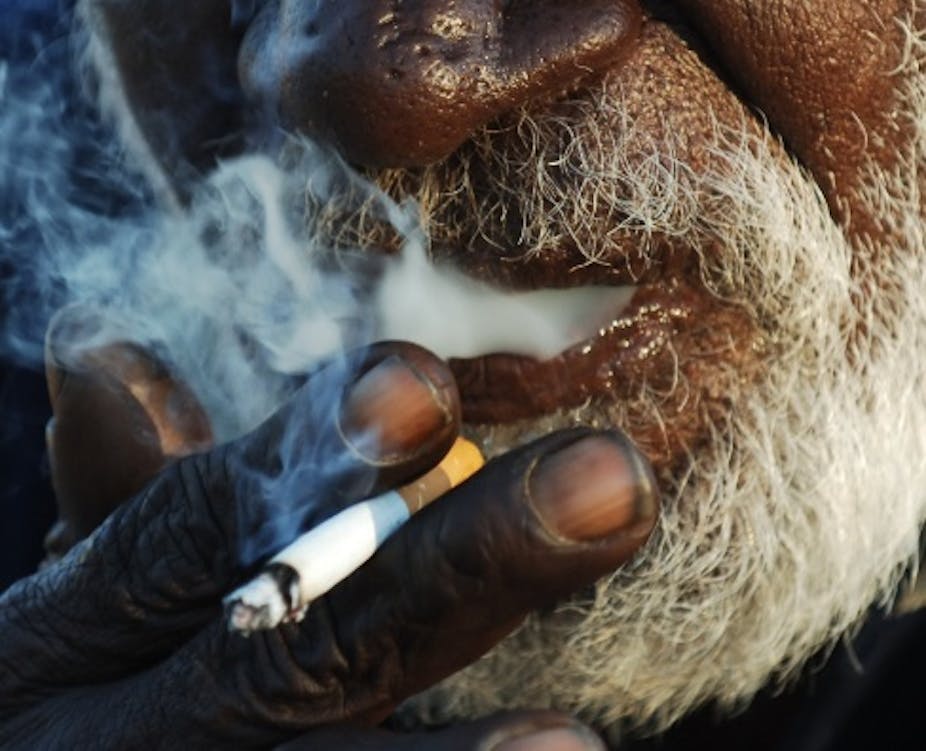Tobacco use is the leading cause of preventable disease and early death among Indigenous Australians, with smoking responsible for about one in every five deaths.
Among Indigenous Australians, tobacco use contributes to 80% of all lung cancer deaths, 37% of heart disease, 9% of all strokes and 5% of low birth-weight babies. And in central Australia, rates of pneumonia among children are reported to be the highest in the world, reaching 78.4 cases per 1,000 children every year.
Although we are seeing reductions in smoking rates across Australia, 42% of Aboriginal and Torres Strait Islander (TSI) people are daily smokers, compared to 16% in the non-Indigenous population. In some remote communities this estimate is as high as 83%.
Smoking is also higher among vulnerable groups: up to two-thirds of Indigenous women continue to smoke during pregnancy, and around 39% of young people aged 15 to 24 years are smoking daily.
You’d think governments would be redoubling their efforts to address the problem. Not so. In fact, the Australian government has recently announced funding cuts of A$130 million over five years to the Tackling Indigenous Smoking program, which amounts to more than one-third of the program’s annual funding.
Tackling Indigenous Smoking funds teams of six health workers to run tailored anti-smoking programs. Each is designed with input and involvement from each community and employ local quit-smoking role models who help other smokers quit by offering advice and support.
Benefits of quitting
We know that quitting smoking reduces the risks of heart disease, lung cancer and other smoking-related issues.
But there are also significant benefits for the health-care system and Australian longer-term budget’s. A recent South Australian study led by Professor Brian Smith, for instance, helped smokers to quit while in hospital and found a direct saving to the hospital budget of A$6,646 per successful quitter within just 12 months.
Another study estimated that the economic impact from just an 8% reduction in the prevalence of tobacco smoking in Australia would result in 158,000 fewer incident cases of disease, 5000 fewer deaths, 2.2 million fewer lost working days and 3000 fewer early retirements. Overall, an 8% reduction in smoking would reduce health sector costs by AU$491 million.
Assessing and funding what works
One of the complicating factors is that the success of Indigenous anti-smoking programs has been patchy. A review I recently published in the Cochrane Collaboration found significant shortcomings for Indigenous quit smoking and youth tobacco prevention programs.
Only one quit smoking study, which was performed in the Northern Territory by Dr Rowena Ivers, met the quality criteria. Dr Ivers’ study found that free nicotine patches might benefit a small number of Indigenous smokers. But none of the study participants completed the full course of nicotine patches and only seven people from the original total of 111 reported that they had quit smoking at six months.
This study suggests programs using nicotine patches can help Indigenous smokers to quit. But much more evidence is needed to determine what options really are the most effective.
Likewise, another review of tobacco prevention programs among young people found potentially harmful results, with one of the three identified studies showing lower smoking rates in the control population. This means that children who received the tailored tobacco prevention program did worse than the youth in the control group who received nothing at all.
It is important to continue evaluating Tackling Indigenous Smoking programs so we know whether or not they work and can direct funding to programs that make a difference. So it’s concerning that part of the funding that is being cut from the budget relates to reviewing these programs.
A long way to go
Five years into the Tackling Indigenous Smoking project, the government has invested a substantial amount of time and money into developing these culturally-tailored programs. Preliminary data released by the government in April found a 3.6% fall in Indigenous daily smoking rates between 2008 and 2013 and a reduction in smoking during pregnancy of 3%.
But cutting resources will make it impossible to meet the program’s ambitious goal of halving Indigenous smoking rates by 2018.
There is still a long way to go. Research shows many health-care workers and some doctors who treat smokers do not believe they have the skills or ability to offer effective preventive health advice. Worryingly, they also admit to the attitude of “even if I did, it’s not going to work, so why bother”.
This response tells us that much more work and subsequently funding is needed to really address the health gaps that remain between Indigenous and non-Indigenous Australians. Tobacco use will remain a problem within our society for as long as we continue to allow it to be one.

